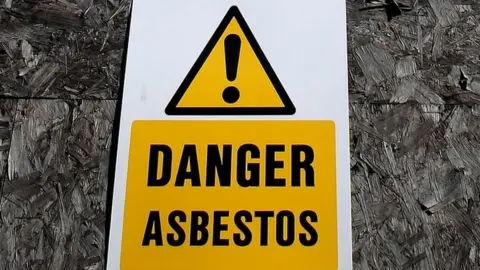MPs say asbestos must go from public buildings within 40 years
 PA Media
PA MediaMPs have called for a 40-year deadline for all asbestos to be removed from public and commercial buildings.
The Work and Pensions Select Committee said asbestos remained the biggest cause of work-related deaths in the UK.
More than 5,000 such fatalities were recorded in 2019.
The Health and Safety Executive (HSE) estimates that asbestos may still be present in 300,000 non-domestic buildings and in many more homes, despite long-term efforts to remove it.
There is currently no target date for the eradication of the material in public buildings, or private homes, in the UK.
Asbestos is classified as being carcinogenic, which means it can cause cancer and other dangerous lung conditions when fibres are inhaled.
The use of any type of the substance was banned in the UK in 1999.
More about asbestos
- Asbestos is a general name given to several naturally occurring minerals that have crystallised to form fibres. These fibres are strong, heat and chemical resistant, and do not dissolve in water or evaporate, leading to asbestos being widely used in building and construction
- Before its use was banned, it featured in many everyday products including insulation material for buildings, boilers and pipes, car brakes, and floor tiles
- There are two types: serpentine (white asbestos) and amphiboles (including blue and brown asbestos); serpentine was more commonly used
- The importation, supply and use of all asbestos has been banned in the UK since 1999; the amphibole type, which is much more hazardous, has been banned since 1985
- Asbestos is not considered harmful when in large pieces and undamaged; but when it is damaged, it can release smaller fibres that are breathed in or swallowed
- Inhaling asbestos can lead to a condition called asbestosis which means an increased susceptibility to cancer
Problem 'to get worse'
The Work and Pensions Committee warned that while "extreme exposures" might be a thing of the past, the risks were likely to escalate.
The retrofitting of buildings to meet net zero requirements meant more materials containing asbestos would be disturbed in the coming decades, the MPs said.
While both the HSE and the government have said they believe it should be removed, the committee said neither had put forward a "clear and comprehensive strategy" for achieving this.
It wants all asbestos removed from non-domestic buildings within 40 years, starting with the highest risk settings such as schools, saying a "clear deadline" would help to "focus minds".
"Simple reliance on a set of regulations which devolve asbestos management to individual duty holders - the building owners or managers responsible for maintenance - will not be good enough," the committee said.
"We need a pan-government and 'system-wide' strategy for the long-term removal of asbestos, founded on strong evidence of what is best from a scientific, epidemiological, and behavioural point of view."
The government has been approached for comment.
